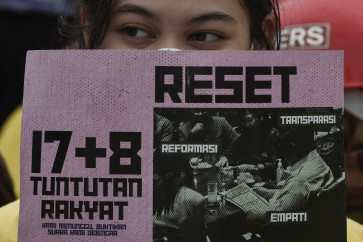Popular Reads
Top Results
Can't find what you're looking for?
View all search resultsPopular Reads
Top Results
Can't find what you're looking for?
View all search resultsRefreshing Moroccan dishes
Moroccan cuisine is unique in the way it combines spices and ingredients
Change text size
Gift Premium Articles
to Anyone
Moroccan cuisine is unique in the way it combines spices and ingredients.
courtesy of the Ritz-Carlton, Pacific Place
The dishes use spices commonly found in Asia, such as ginger and turmeric. Its cooking method adopts the European style, particularly Andalusian, and Moroccan cuisine is influenced mostly by the Jewish and the Arab people who live in the area.
Salah Lim from the Moroccan Embassy in Jakarta said that the cuisine found in Fez would be different from the one found in Marrakesh or that in in Casablanca. However, he added, when it comes to breaking the fast during Ramadan, Moroccans have one special dish they must have on the table, a soup called harira.
“Made from tomatoes, lentils, chickpeas and lamb, the soup is believed to be the best meal to replenish the body after a day of fasting,” Limi said.
Moroccan chef Amine Abdelmounaime from the Ritz-Carlton in Doha, Qatar said that harira soup was served with four condiments: boiled eggs, dates, lemons and chebakia or cookies with honey.
“During Ramadan, the price of celery, tomatoes and chickpeas can triple and sometimes quadruple as those are the basic ingredients to make harira. But people still buy them anyway, because harira is a must-have dish for breaking the fast,” he said.
Other snacks served for breaking the fast are croissants with honey, baghrir (Moroccan pancakes), fruit-flavored milkshakes, coffee and Moroccan mint tea.
Moroccans have their dinner later at night, around 11 p.m. Menus vary, but food is usually cooked in a tajine, a Moroccan claypot with a knob-like handle. Tajine is also the name of the stew cooked in that type of pot.
Chef Abdelmounaime said that Moroccan cuisine was comprised mostly of chicken or lamb dishes. It also uses olive oil, olives, tomatoes, onion, coriander, parsley, celery, lettuce and green bell peppers. The cuisine favors spices such as ginger, cumin, turmeric, saffron and chili.
If it is Friday, then you can have couscous, a dish that is only served on that day. Couscous is made from wheat and served with zucchini and turnips. Couscous can take up to four hours to prepare. But why only on Fridays?
Chef Abdelmounaime said that in the past, Moroccans had their day-off on Fridays. Although they now adopt Sundays as a day-off, people working in the “old professions”, such as carpenters and ceramic makers, still take Fridays off.
“In Morocco, there are many people in the old professions. We call them the artisans. When they are off on Fridays, they have lunch with their families at home. For Ramadan, it’s dinner. Since it’s such a special occasion, their wives make a special dish, couscous,” he said.
Since Moroccans have a late dinner, most do not wake up for the pre-dawn meal. Those who eat a pre-dawn meal typically have a simple cup of tea with bread.
For a taste of Moroccan cuisine this Ramadan, you can head to the Ritz-Carlton Pacific Place Jakarta, where Chef Abdelmounaime will serve his specialty foods until Idul Fitri, or to Maroush restaurant at the Hotel Crown Plaza.










